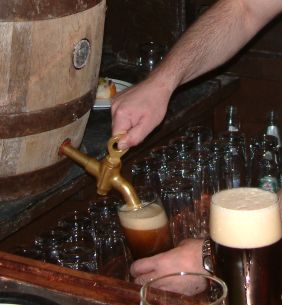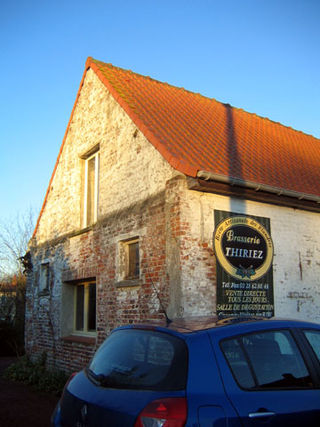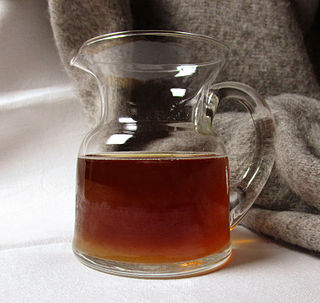Related Research Articles

Beer is an alcoholic beverage produced by the brewing and fermentation of starches from cereal grain—most commonly malted barley, although wheat, maize (corn), rice, and oats are also used. The grain is mashed to convert starch in the grain to sugars, which dissolve in water to form wort. Fermentation of the wort by yeast produces ethanol and carbonation in the beer. Beer is one of the oldest alcoholic drinks in the world, the most widely consumed, and the third most popular drink after water and tea. Most modern beer is brewed with hops, which add bitterness and other flavours and act as a natural preservative and stabilising agent. Other flavouring agents, such as gruit, herbs, or fruits, may be included or used instead of hops. In commercial brewing, natural carbonation is often replaced with forced carbonation.

Mead, also called honey wine, and hydromel, is an alcoholic beverage made by fermenting honey mixed with water, and sometimes with added ingredients such as fruits, spices, grains, or hops. The alcoholic content ranges from about 3.5% ABV to more than 20%. Possibly the most ancient alcoholic drink, the defining characteristic of mead is that the majority of the beverage's fermentable sugar is derived from honey. It may be still, carbonated, or naturally sparkling, and despite a common misconception that mead is exclusively sweet, it can also be dry or semi-sweet.

Homebrewing is the brewing of beer or other alcoholic beverages on a small scale for personal, non-commercial purposes. Supplies, such as kits and fermentation tanks, can be purchased locally at specialty stores or online. Beer was brewed domestically for thousands of years before its commercial production although its legality has varied according to local regulation. Homebrewing is closely related to the hobby of home distillation, the production of alcoholic spirits for personal consumption, but home distillation is generally more tightly regulated.

Pale ale is a golden to amber coloured beer style brewed with pale malt. The term first appeared in England around 1703 for beers made from malts dried with high-carbon coke, which resulted in a lighter colour than other beers popular at that time. Different brewing practices and hop quantities have resulted in a range of tastes and strengths within the pale ale family. Pale ale is a kind of Ale.

Wheat beer is a top-fermented beer which is brewed with a large proportion of wheat relative to the amount of malted barley. The two main varieties are German Weizenbier and Belgian witbier; other types include Lambic, Berliner Weisse, and Gose.

Pale lager is a pale-to-golden lager beer with a well-attenuated body and a varying degree of noble hop bitterness.

India pale ale (IPA) is a hoppy beer style within the broader category of pale ale.
Charles N. Papazian is an American nuclear engineer, brewer and author. He founded the Association of Brewers and the Great American Beer Festival, and wrote The Complete Joy of Home Brewing (1984). He is the longtime former president (1979–2016) of the Brewers Association. He is also the creator of the National Pie Day, a celebration of pies which is celebrated on January 23, Papazian's birthday.

Beer styles differentiate and categorise beers by colour, flavour, strength, ingredients, production method, recipe, history, or origin.
Dave Line was a British beer author. An electrical engineer by profession, he is regarded as a pioneer in homebrewing during the 1970s because at the time homebrewing as a hobby was in its infancy. At the time of his early death from cancer he was 37, living in Southampton, was married and had a son.

Mash ingredients, mash bill, mashbill, or grain bill are the materials that brewers use to produce the wort that they then ferment into alcohol. Mashing is the act of creating and extracting fermentable and non-fermentable sugars and flavor components from grain by steeping it in hot water, and then letting it rest at specific temperature ranges to activate naturally occurring enzymes in the grain that convert starches to sugars. The sugars separate from the mash ingredients, and then yeast in the brewing process converts them to alcohol and other fermentation products.

Strong ale is a type of ale, usually above 5% abv and often higher, between 7 and 11% abv, which spans a number of beer styles, including old ale, barley wine, and Burton ale. Strong ales are brewed throughout Europe and beyond, including in England, Belgium, and the United States.

Otto Frederick Eckhardt was an American brewer, homebrewing advocate, and writer. Eckhardt is best remembered as a pioneer in the field of beer journalism, publishing a series of articles and books on the topic, including the seminal 1989 tome, The Essentials of Beer Style. At the time of his death in 2015, Eckhardt was memorialized as "the Dean of American beer writers".

Brasserie Thiriez is a small craft brewery located in Esquelbecq, a town in the Arrondissement of Dunkirk in the Nord département, in the Hauts-de-France région of France, quite close to the Belgian border. It is situated on the grounds that formerly housed the Poitevin farm brewery, which was active and served the local area until 1945. The current brewery was founded in 1996 by Daniel Thiriez, who had become interested in homebrewing as a college student, and later left his career as a "human resources professional for a large supermarket chain" in the interest of reviving the tradition of the small village brewery. It exports beers in Europe, and the USA.

Saaz is a "noble" variety of hops. It was named after the Czech town of Žatec. This hop is used extensively in Bohemia to flavor beer as the Czech pilsner.
In brewing, attenuation refers to the conversion of sugars into alcohol and carbon dioxide by the fermentation process; the greater the attenuation, the more sugar has been converted into alcohol. A more attenuated beer is drier and more alcoholic than a less attenuated beer made from the same wort.

Gotlandsdricka is a traditional homebrewed alcoholic beverage made on the island of Gotland, Sweden. It is a kind of ale, closely related to the Finnish sahti, and Norwegian maltøl with a smoky, bitter-sweet, spicy (juniper) flavor. It is similar to gruit.

Dragonmead is a U.S. microbrewery, meadery and brewpub founded by Earl Scherbarth, Larry Channell, and Bill Wrobel in January 1997. The small brewery produces many varieties of beer, wine, and mead, and has received awards including gold medals at the World Beer Cup.

Experimental beer is beer that is produced in or as a new style, using a new recipe, or as a type of beer that does not fit within present beer style criteria or definitions. The term also encompasses minor beer styles that are not covered under any of the Beer Judge Certification Program (BJCP) categories, with the exception of Belgian beers. Such minor beer styles may serve "as an incubator" for new potential categories, and may attain an official category if the style becomes of interest to the general public at a sufficient level. The Great American Beer Festival has an experimental beer category as a part of its competition, for which awards are given, as does the World Beer Cup, which also provides awards for beers in this category. The Oregon State Fair has a home brew competition that includes a category for specialty and experimental beers.
Santiago Graf was a Swiss born brewer, businessman, and director and manager of Compania Cervecera Toluca y Mexico. He was the first successful brewer of lager beer in Mexico and pioneered the "Graf" style of Vienna lager, one of the two styles of Vienna lager today and still popular in Mexico and the southwest United States.
References
- ↑ howtobrew.com
- ↑ The Brew Your Own Big Book of Homebrewing: All-Grain and Extract Brewing". Voyageur Press. 1 Jan 2017. p. 147.
- ↑ Tonsmeire, Michael (June 15, 2014). American Sour Beer: Innovative Techniques for Mixed Fermentations". Brewers Publications. p. 12.
- ↑ Strong, Gordon (16 May 2011). Brewing Better Beer: Master Lesson for Advanced Homebrewers". Brewers Publications. p. 6.
- ↑ Realbeer.com Retrieved on 2009-06-04.
- ↑ Brewers Publications Retrieved on August 21st 2012